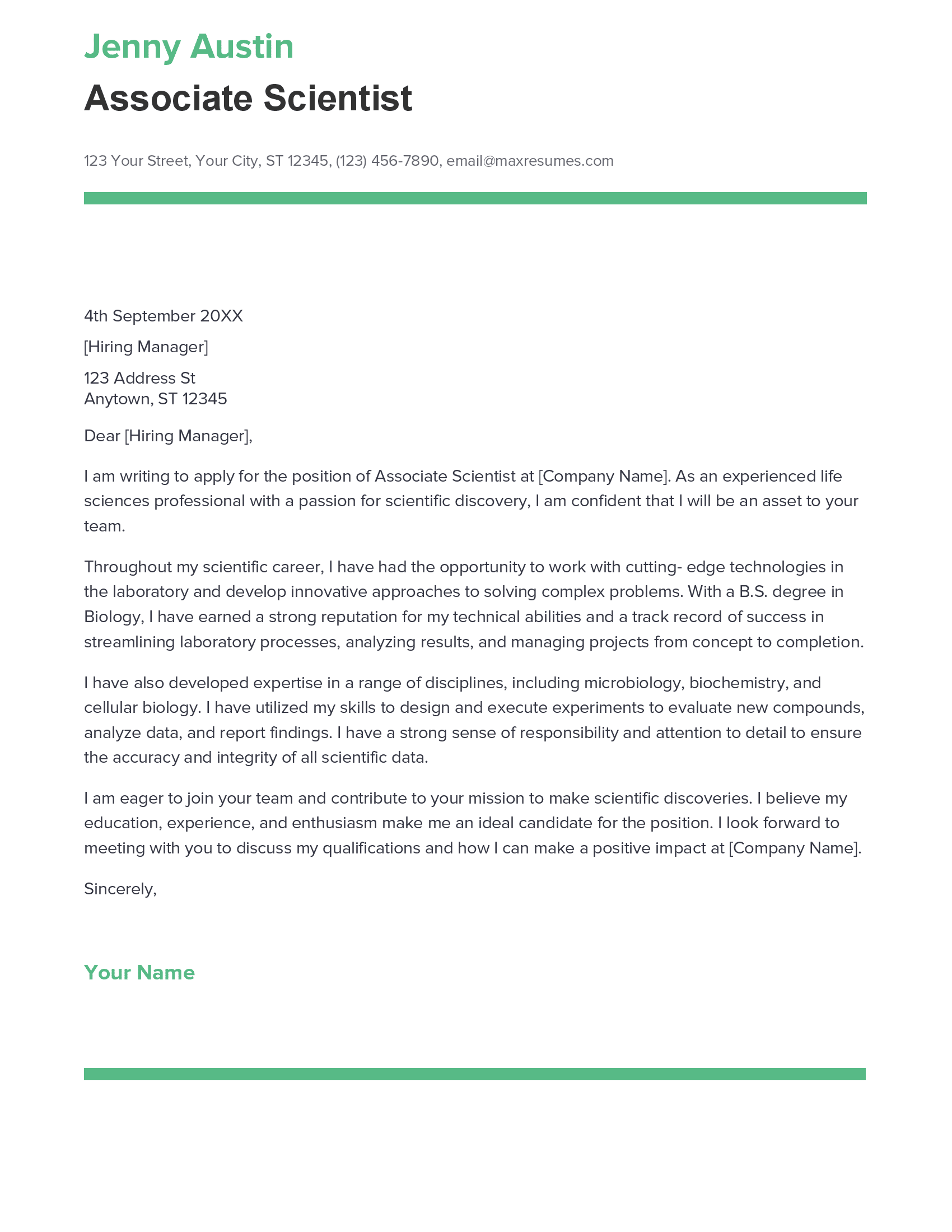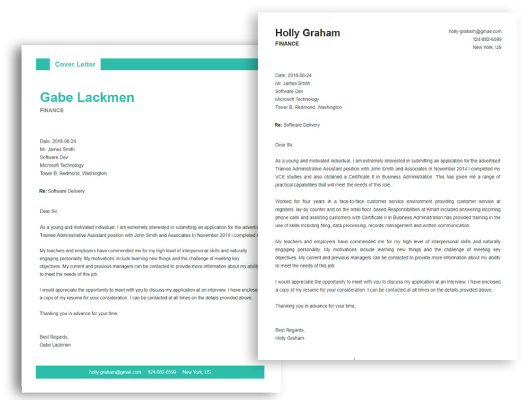Finding the right job opportunity can be a challenge, but once you do, expressing your qualifications and experience in a professional and convincing way can be just as difficult. A great way to stand out from the competition is by writing an effective and personalized cover letter for the role of associate scientist. This guide will provide information on how to structure and compose an effective cover letter for the associate scientist role, along with an example to help you get started.

Download the Cover Letter Sample in Word Document – Click Below
If you didn’t find what you were looking for, be sure to check out our complete library of cover letter examples.

Start building your dream career today!
Create your professional cover letter in just 5 minutes with our easy-to-use cover letter builder!
Associate Scientist Cover Letter Sample
Dear [Hiring Manager],
I am writing to apply for the position of Associate Scientist at [Company Name]. As an experienced life sciences professional with a passion for scientific discovery, I am confident that I will be an asset to your team.
Throughout my scientific career, I have had the opportunity to work with cutting- edge technologies in the laboratory and develop innovative approaches to solving complex problems. With a B.S. degree in Biology, I have earned a strong reputation for my technical abilities and a track record of success in streamlining laboratory processes, analyzing results, and managing projects from concept to completion.
I have also developed expertise in a range of disciplines, including microbiology, biochemistry, and cellular biology. I have utilized my skills to design and execute experiments to evaluate new compounds, analyze data, and report findings. I have a strong sense of responsibility and attention to detail to ensure the accuracy and integrity of all scientific data.
I am eager to join your team and contribute to your mission to make scientific discoveries. I believe my education, experience, and enthusiasm make me an ideal candidate for the position. I look forward to meeting with you to discuss my qualifications and how I can make a positive impact at [Company Name].
Sincerely,
[Your Name]
Looking to improve your resume? Our resume examples with writing guide and tips offers extensive assistance.
What should a Associate Scientist cover letter include?
A cover letter is an important part of the job search process and should be tailored specifically to the position you are applying for. As an Associate Scientist, your cover letter should be professional and highlight your expertise and experience in the field. Here are some of the key elements to include in your cover letter:
- Introduction: Introduce yourself, mention the position you are applying for, and how you found out about the job.
- Summarize your qualifications, skills, and relevant experience that make you an ideal candidate for the position.
- Core Competencies: Highlight the most important skills that make you a great fit for the job, such as problem solving, analysis, and critical thinking.
- Professional Background: Provide a brief overview of your professional experience, such as your current job and any previous work in the field.
- Education and Credentials: Outline your academic qualifications and any relevant certifications or awards that demonstrate your commitment to your profession.
- Closing: Provide a brief summary of why you would be the best candidate for the job, and thank the reader for their time.
Associate Scientist Cover Letter Writing Tips
Writing a cover letter for an Associate Scientist position can be a daunting task. However, understanding the basics of cover letter writing can help you create an effective cover letter that will help you stand out among the competition. Here are some tips to help you write a great cover letter for an Associate Scientist position:
- Highlight your research experience: Showcase your previous research experience and knowledge in the areas related to the position you are applying for. Demonstrate how your research experience and knowledge can be beneficial to the company.
- Share your achievements: Highlight any awards or achievements you have won in the past that relate to the Associate Scientist position.
- Showcase your problem- solving skills: Demonstrate how you are a critical thinker and problem solver. Include any experiences where you have had to solve difficult problems in the past.
- Utilize action verbs: Use strong action verbs to show the hiring manager you have the skills necessary for the Associate Scientist position.
- Show your enthusiasm: Express your enthusiasm for the position and the company. Demonstrate why you would make a great fit for the company and the team.
- Proofread: Finally, make sure to read your cover letter carefully and edit for any errors before submitting. This is important because it can make the difference between your cover letter getting noticed or not.
Common mistakes to avoid when writing Associate Scientist Cover letter
A cover letter is often a job seeker’s first impression on potential employers and should be carefully crafted in order to be effective. Writing an Associate Scientist cover letter is no different. Here are some common mistakes to avoid when writing an Associate Scientist cover letter:
- Not Tailoring Your Cover Letter: It is important to customize your cover letter to the specific job and employer. Using generic language and templates can make your cover letter seem unoriginal and unconvincing.
- Forgetting to Include Keywords: Many employers utilize special tracking systems to review applications, so be sure to include keywords from the job posting in your cover letter. This will help ensure your application stands out from the rest.
- Focusing Too Much on Yourself: While it is important to highlight your experience and skills, it is also important to show how you can benefit the employer. Focus on how your knowledge and experience can contribute to their organization or project.
- Not Following Instructions: Be sure to follow all instructions and guidelines provided by the employer. If a cover letter is optional or not required, consider submitting one anyway as it can show your attention to detail and commitment to the job.
- Not Proofreading: Before submitting your cover letter, look for any typos or grammatical errors. It is important to make sure that your letter is professional and error- free.
By avoiding these common pitfalls, you can ensure that your Associate Scientist cover letter stands out and makes a positive impression on potential employers.
Key takeaways
Writing a cover letter for an Associate Scientist position can seem overwhelming and daunting. After all, you need to demonstrate your qualifications and skills in just a few paragraphs. However, if you approach the task methodically, you can create an impressive cover letter that will get you the job. Here are some key takeaways for writing an outstanding Associate Scientist cover letter:
- Start off with a strong opening statement that grabs the employer’s attention.
- Make sure to mention your relevant qualifications and experience, focusing on how you can contribute to the role and company.
- Demonstrate your scientific knowledge and abilities by mentioning specific projects and experiments you have conducted.
- Showcase your analytical skills and problem- solving abilities.
- Highlight your ability to work in a team and collaborate with other scientists.
- Demonstrate your commitment to staying current with scientific advances, including attending conferences and reading up on relevant research.
- Keep it professional and concise, making sure to avoid any errors.
- End on a positive note by expressing your enthusiasm for the opportunity and thanking the employer for their consideration.
By following these key takeaways, you can create an impressive cover letter for an Associate Scientist position that will set you apart from the competition.
Frequently Asked Questions
1.How do I write a cover letter for an Associate Scientist job with no experience?
Writing a cover letter for an Associate Scientist job with no experience can be challenging, but it is possible to craft an effective and compelling document. Start by highlighting relevant skills, such as problem- solving, research, communication, and data analysis. Focus on what you have achieved in other roles that have prepared you for becoming an Associate Scientist, such as internships, volunteer work, and academic projects. Additionally, explain why you’re passionate about the job and why you think you’d be an excellent candidate. Finally, be sure to be concise and avoid errors.
2.How do I write a cover letter for an Associate Scientist job experience?
When writing a cover letter for an Associate Scientist job with experience, be sure to emphasize your accomplishments. List any achievements, such as success in managing a team or any awards or recognitions, and how they’ve prepared you for this role. Additionally, explain how your knowledge and skills make you an ideal candidate for the position. Be sure to include specifics such as how many years of experience you have, what scientific processes you are familiar with, and any research you’ve conducted.
3.How can I highlight my accomplishments in Associate Scientist cover letter?
When highlighting your accomplishments in an Associate Scientist cover letter, be sure to provide specific examples of successes. Explain how you have used your knowledge and skills to enhance processes, produce results, and solve problems. Additionally, provide details on any awards and recognitions, such as publications or grants, or any success stories from previous employers. You can also mention any scientific research you have conducted for further evidence of your capabilities.
4.What is a good cover letter for an Associate Scientist job?
A good cover letter for an Associate Scientist job should be tailored to the specific role and company. Start by researching the company and the position to get a better understanding of the job requirements. Then, use the cover letter to explain why you’re a great fit for the role. Focus on the skills and accomplishments that make you stand out, such as problem- solving, communication, and data analysis. Additionally, be sure to provide details on any awards and recognitions, any research you’ve conducted, and any scientific processes you’re familiar with. Finally, wrap up the letter by expressing your interest and enthusiasm for the role.
In addition to this, be sure to check out our cover letter templates, cover letter formats, cover letter examples, job description, and career advice pages for more helpful tips and advice.
Let us help you build
your Cover Letter!
Make your cover letter more organized and attractive with our Cover Letter Builder
